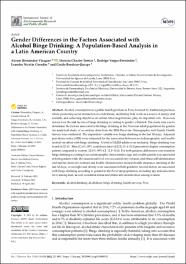| dc.contributor.author | Hernández-Vásquez, Akram | es_ES |
| dc.contributor.author | Chacón-Torrico, Horacio | es_ES |
| dc.contributor.author | Vargas-Fernández, Rodrigo | es_ES |
| dc.contributor.author | Nicolás Grendas, Leandro | es_ES |
| dc.contributor.author | Bendezu-Quispe, Guido | es_ES |
| dc.date.accessioned | 2022-11-07T19:31:30Z | |
| dc.date.available | 2022-11-07T19:31:30Z | |
| dc.date.issued | 2022-04-19 | |
| dc.identifier.uri | https://hdl.handle.net/20.500.13053/7012 | |
| dc.description.abstract | “Alcohol consumption is a public health problem in Peru, fostered by traditional practices,
where promoting social interaction in celebrations, facilitating field work as a source of energy and
warmth, and achieving objectives in certain labor negotiations, play an important role. However,
research on the risk factors of binge drinking according to gender is limited. The study aim was to
determine the factors associated with binge drinking in the Peruvian adult population by gender.
An analytical study of secondary data from the 2018 Peruvian Demographic and Family Health
Survey was conducted. The dependent variable was binge drinking in the last 30 days. Adjusted
prevalence ratios (aPR) were estimated for the association between sociodemographic and healthrelated variables with binge drinking. A total of 32,020 adults were included. Binge drinking was
found in 22.4%. Men (32.6%; 95% confidence interval [CI]: 31.4–33.8) presented a higher consumption
pattern compared to women (12.8%; 95% CI: 12.0–13.6). For both genders, differences were found in
binge drinking according to sociodemographic characteristics (age and wealth quintile was associated
in both genders while the educational level was associated only for men, and ethnic self-identification
and marital status for women) and health- characteristics related (health insurance, smoking in the
last 30 days, overweight and obesity were associated in both genders). Several factors are associated
with binge drinking according to gender in the Peruvian population, including age and education
level among men, as well as marital status and ethnic self-identification among women.“ | es_ES |
| dc.format | application/pdf | es_ES |
| dc.language.iso | eng | es_ES |
| dc.publisher | MDPI | es_ES |
| dc.rights | info:eu-repo/semantics/openAccess | es_ES |
| dc.rights.uri | https://creativecommons.org/licenses/by/4.0/ | es_ES |
| dc.subject | alcohol drinking; alcoholism; binge drinking; health surveys; Peru | es_ES |
| dc.title | Gender Differences in the Factors Associated with Alcohol Binge Drinking: A Population-Based Analysis in a Latin American Country | es_ES |
| dc.type | info:eu-repo/semantics/article | es_ES |
| dc.identifier.doi | https://doi.org/10.3390/ijerph19094931 | es_ES |
| dc.type.version | info:eu-repo/semantics/publishedVersion | es_ES |
| dc.publisher.country | CH | es_ES |
| dc.subject.ocde | http://purl.org/pe-repo/ocde/ford#3.03.00 | es_ES |


